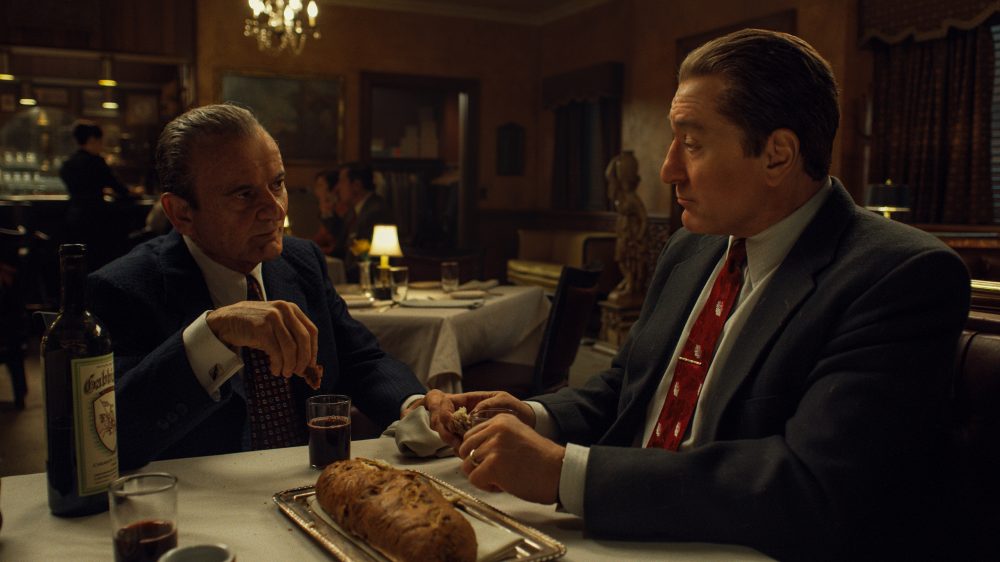How ‘The Irishman’ DP Rodrigo Prieto Juggled Menace and Beauty
By Jazz Tangcay
LOS ANGELES (Variety.com) – Martin Scorsese first informed cinematographer Rodrigo Prieto about “The Irishman” on the set of “Silence.”
Prieto went away, read the script and immediately said yes to it.
With the storyline spanning five decades, one of the first challenges Prieto looked at was how to create distinct looks for the passing of time. “I emulated the emulsions. For the ’50s, it was Kodachrome, and then, for the ’60s, it was Ektachrome,” Prieto explained. Moving into the ’70s, Prieto used a process called ENR. “It’s a process that takes color away and adds contrast. It was developed by Technicolor Rome for Vittorio Storaro.”
Aside from the challenge of de-aging the actors, one scene that stood out for Prieto was lighting the “Frank Sheeran Appreciation Night” sequence. “It was so layered because so many things were happening in it,” explains Prieto. “On the one hand, it’s a celebration and there needed to be this upbeat feel to it. At the same time, that scene needed to have a feeling of menace and beauty.”
Prieto frames the sequence and breaks down how “Network” and “Goodfellas” helped to overcome his main challenge with lighting.
Frank Sheeran Appreciation Night
The biggest misconception is that people think we had a big budget and a luxurious schedule. In fact, it was quite tight. We had over 300 scenes and many different locations.
We had to complete this scene in four days.
The place where we shot had arched ceilings, so that meant we couldn’t rig any overhead ambient light. That lighting needed to be red. I needed a practical lighting plan and I had to shoot as quickly as possible.
My daughter was watching “Network” one evening and I was watching it with her. There’s a banquet hall scene, and the lamps had red shades on them. There was a single spotlight on stage. Those red lamp shades bathed the whole scene in red light and it symbolized blood.
There’s another scene in “Goodfellas” where the brake light is lighting the scene as they’re putting the dead body in the car. I remember being struck by that scene. I thought it was a great opportunity for the scene.
I ended up using small theatrical birdies. They’re miniature lanterns and they’re like parcans. I put those around the second-floor balcony and created a row of spotlights that created a golden wash over the scene.
It was this combination of a golden backlight with the red lamps bathing the scene.
I used the spotlight that was on stage to highlight dramatic moments when people were dancing.
I highlighted when Tony Pro is looking at Hoffa and Peggy dancing. I strategically passed the spotlight through her as she notices. When the camera pans over, the spotlight goes through them.
The other part was there were all these other menacing moments where we discover that Hoffa is not going to relent and listen to Buffalino. It needed to feel dark, menacing and intimate and have that underlying emotional conflict.
Frank and Russell’s Road Trip
This goes back to the logistical issues. I’ve shot a lot of scenes where you tow the car with a camera car and the director is in the vehicle, and the sister car is on a platform and towed around. There’s lighting around the car, and you close the street down, fill it with period cars and extras.
You do one pass. You stop and let the other cars go by, and then you go back and do your second take. It takes a lot of time, but that was one thing we didn’t have.
We weren’t going to shoot on a soundstage. So, I suggested using LED walls to light the scene.
That meant we needed to shoot the background in every direction. A second unit went out and they would lock down the streets. But they had nine cameras to capture everything.
The videos I used to feed the LED walls were 9×6 feet. I had three walls and two panels.
We’d start shooting, roll the video and light their faces how we needed to. That’s why it feels like they are there because it’s so interactive.
If they drove pass a brick building, I’d show the reflection of the red brick on their face and glasses. If they passed a park, you’d see that in the reflection, but you’d also see it in the background.
It solved the problem.
It really solved another major problem. It’s the beginning of the road trip. You see the two men in the front and the wives are at the back.
The camera is outside the windshield, and it needed to travel through the windshield, over Russell, and onto this close up of his wife.
How do you do that with a moving vehicle? I knew we could have zoomed in, but I knew that wouldn’t have been as emotional.
The only way to have done that was through the LED walls and in the studio. It’s how we achieved the shots we needed to.

